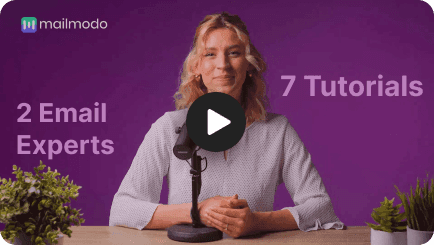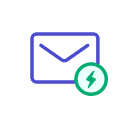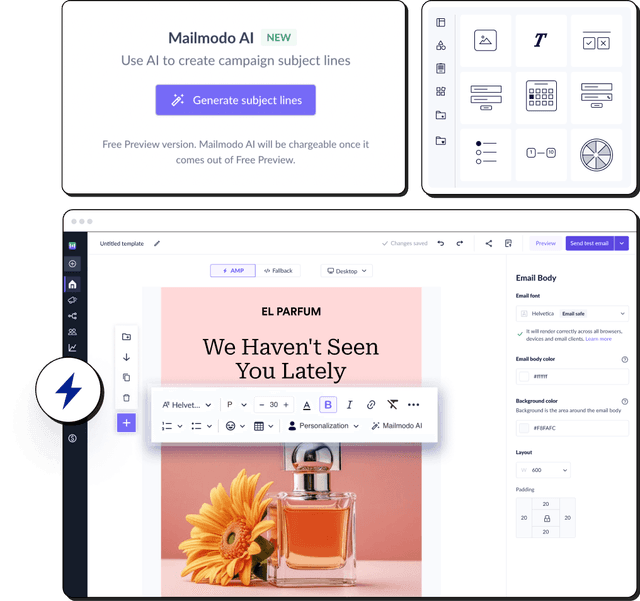How does an email client detect and mark emails as spam?
Do you think only spam emails reach the spam folder? Absolutely not!
There is a chance for your emails to land in the spam folder even if you are a trusted business. This is because spam filters and anti-spam software such as SpamAssassin identify the red flags by scanning emails. And in those scans, if they find anything they consider spam, your emails get flagged as spam.
So, let's understand how anti-spam software and filters detect spam messages. When you start sending emails to your subscribers, it will land in the inbox only after the filters verify it.
Why do emails go to spam?
Is it possible for even my legitimate emails to land in the recipient's spam? Absolutely yes! Because security measures are smart, even a small mistake can land your legitimate email in the spam folder.
Here are some critical points stating how emails can land into the spam folder instead of the inbox. These points become especially important when you are sending bulk emails.
1. You have a low IP reputation
Your IP address gets shared whenever you send an email. Sharing an IP address has many drawbacks.
For example, if your IP has a negative reputation from the current or previous senders with poor habits, it can be the reason for your email landing in the spam.
Ensure that you are managing your IP reputation well. Google & Hotmail have their postmaster tools which allow you to track the IP reputation. You must make sure that if you have allotted a shared IP pool, only clients with good mailing practices share the IP pool so that the mailing by one brand doesn't affect the other brand.
2. You have a low domain reputation
Good domain reputation is important for email deliverability. Good domain reputation improves inbox placement, lowers bounce rates, and enhances engagement, as recipients are more likely to trust and open emails from reputable domains. However, a bad domain reputation can significantly hamper your customer engagement and increase the chance of your email landing in spam.
Email volume increasing inconsistently is another primary reason your emails land in the spam folder.
3. You have poor email design and irrelevant content
If your content is irrelevant to the recipient, the recipient will likely engage negatively with your email. Moreover, when you use too many images, links, and less text, your message appears spammy, which is a clear red flag for the spam filters.
Also, most of the spam filters are AI-based. So if the content has had a history of hitting spam, even if you have changed the entire email headers, the chances of hitting the inbox are minimal. However, AI systems are not foolproof some sophisticated AI scams mimic legitimate marketing or transactional emails, tricking both filters and users.
4. You receive negative engagements
Negative engagement means your emails are being reported as spam. So, spam complaints should be minimized as far as possible. But, even with high open rates, if users open your emails to report spam, the reputation will come down, and you will start hitting the spam box more frequently. Hence, getting the cadence right - targeting the right users at the right time with the right content is important.
5. Your email has HTML issues
If you have different HTML email versions, broken HTML, or even a plain text version, it will automatically reach the spam folder. This is because it appears unreadable and sloppy on every email client when broken HTML. So, your users will start marking your emails as spam when they see broken HTML.
6. Your email authentication fails
If you have been passing SPF & DKIM and suddenly start failing due to some configuration issue or DNS failure, the emails have a very high chance of landing in spam. Hence it's necessary to keep an on all authentication protocols while monitoring your infrastructure.
7. You don't provide an unsubscribe link
Imagine sending an email to a recipient with little interest in your product. Naturally, they'd want to unsubscribe from getting further emails. But if you don't have an unsubscribe button in the email, there are chances that the recipient will report your email as spam, which we already know is a negative trend.
So it is crucial to give users a clear way out or manage their preferences. Learn more about email unsubscribe rates and email preference centers.
8. You have a bad proportion of active users
You must maintain a balance between active and inactive users in your mailing list. The percentage of active users needs to outweigh the percentage of inactive users. If inactive users start outweighing the active users, your emails will start landing in the spam.
Escape the spam folder with managed deliverability
How to avoid spam emails
There are many reasons for emails landing in the spam folder. Some of them are email authentication status, diligence in analyzing the email metrics, email list health, the value you offer your recipient with your email content, etc. A few tips you can use to keep your emails out of the spam folders are:
1. Build your email list
You need to be aware of your messages to your targeted audience. If you are sending the wrong message to your targeted audience or using the right message to an unengaged audience, both are considered a waste of time and will send your IP address to the spam list.
Ensure you avoid the following:
If you need a long-term benefit with an email program, you must build your email list organically. Developing a trustworthy plan is difficult, but you don't have to worry about longevity once you have sketched one.
2. Authenticate your email
Though authentication of your email is tricky, it can bring many benefits when sending a legitimate email. Yahoo, Google, and other inbox providers focus on authenticated email; therefore, your email directly reaches the inbox instead of the spam folder.
DMARC influences the power of SPF and DKIM; when you meet this standard, you can ensure there are no chances of email tampering during transmission.
3. Obtain users' consent
Obtaining the users' consent in the sign-up flow will help keep your email deliverability and engagement rates high. Performing a full-fledged domain warmup before starting campaigns with a new domain and asking email users to drag the email from different tabs (like spam, promotions, etc.) to their primary inbox folder are good tips to ensure your emails land in inbox.
4. Monitor reputation by avoiding deny lists
You will be on the email deny list( (blacklist) if your email domain reputation slips or when you send an email to any of the spam trap emails. So there is even a chance for the well-intentioned and cautious senders to fall into the email deny list.
Below are a few best practices you should follow to reduce this risk of falling into the email deny list:
Make use of the real-time email address validation.
Remove unengaged subscribers by implementing a sunset policy. Sunset policy is the practice of getting inactive users out of your email list. Cleaning your email list regularly will help stop the low email engagement rate. Being proactive is essential for receiving improved email deliverability rates.
Ask subscribers to whitelist your email.
5. Track the engagement metrics of your emails
You can quickly know if any changes are needed in your email or if your email program is improving by tracking the engagement metrics and email performance. You can also build a few baseline metrics to have a clear picture of the email performance. Click-through rates, open rates, and spam complaints are some of the metrics you can follow.
6. Improve your email design, content, and structure
There are many practices to follow while you design an email. Few are as follows:
It's easy for people to recognize you when your email aligns with the brand. It includes logo, tone, images, fonts, colors, etc.
Ensure your email copies are to the point, simple, and easily readable for your targeted customers.
The email you send needs to be responsive for all devices like desktop and mobile.
Don't just include images. Your text and image ratio should balance each other for a perfect email template.
Personalize your emails wherever and whenever possible to enhance the user experience.
If you are sending a marketing email, your email should contain a physical address.
Avoid using a no-reply email address.
End your email with the right salutation.
Read our comprehensive guide on how to improve email design for more tips to get higher deliverability.
How to check if your emails are landing in the spam folder
There are plenty of free tools available online that can help detect deliverability, test your reputation, and render the quality of email content, subject lines, and more. But in this guide, we have covered an all-in-one free tool that can do everything without much hassle - Google Postmaster.
Google Postmaster
Google Postmaster tool is a free email analytics tool that enables businesses to analyze different factors based on email performance. The tool offers insights into the email sending practices’ problematic areas and provides a solution to enhance deliverability and email success rate.
How to activate Google Postmaster tools
If you want to send more than 100,000 email addresses with a larger email size, visit Google Postmaster tools to follow the verification process. While activating the tool, you will be asked to install Google Search Console. You will be able to access information and reports on your domain reputation, spam rate, authentication, delivery errors, IP reputation, feedback loop, and encryption once you set up your account and verify the domain.
There are important factors to understand about these metrics and data points. They include the following:
Google Postmaster tools focus only on messages associated successfully with a domain through DKIM or SPF authentication. Therefore, if an organization does not have an authenticated email with its domain, Google Postmaster will not access that data.
The Google Postmaster tool has a minimum email volume threshold for data to populate. Messages to "@gmail.com" users will only be shown in the Google Postmaster Tool metrics, and therefore, there is no chance for emails sent to G Suite or Google Workspace to accrue in the platform.
The reports from Google Postmaster will be updated once a day by taking into account the previous day's performance insights. Most of the data is populated usually around 7.00 PM UTC or 12:00 PM Pacific. It means there would be a lag in the data availability. When there is a delay, the Google Postmaster tool cannot track specific campaign performance.










